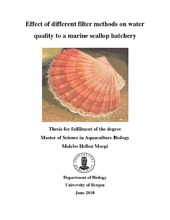| dc.contributor.author | Moepi, Malebo Hellen | eng |
| dc.date.accessioned | 2010-09-07T10:23:17Z | |
| dc.date.available | 2010-09-07T10:23:17Z | |
| dc.date.issued | 2010-05-31 | eng |
| dc.date.submitted | 2010-05-31 | eng |
| dc.identifier.uri | https://hdl.handle.net/1956/4098 | |
| dc.description.abstract | Water quality in marine hatcheries is a critical aspect in the production of spat. Different filtering methods have been used to treat the intake seawater in the hatcheries. The Scalpro AS hatchery uses two different types of filters to treat seawater, an active filter media and drum filter. The objective of this study was to establish a better knowledge on the effect of different filtering methods on marine water quality in the production of great scallop (Pecten maximus). The two filters were compared in relation to chemical and microbial properties, microbial communities and microalgal cell numbers. Egg development to day 3 larvae was performed by using water from both treatments. A larval activity experiment was conducted by exposing 8 days old larvae to different water treatments and concentrations. There was no significant difference between treatments in dissolved oxygen (% and mg l-1) while temperature at the skimmer after active filter media was significantly higher than other sampling points. Both treatments reduced the total, dissolved and particulate organic carbons concentrations from the intake water. The skimmer significantly reduced the total bacterial numbers from the drum filter in March. In March, April and May, no Vibrios spp. was found in other sampling points except the drum filter in March. The numbers of culturable heterotrophic bacteria in April were increased at the skimmer after active filter media from the intake water and reduced at the skimmer after drum filter. In May, both skimmers reduced the bacterial colonies from the intake water. Close similarities of microbial community were observed between the intake water and each treatment. From the denaturing gradient gels profiles it seemed that alpha proteobacteria dominated in March and gamma proteobacteria (opportunistic) dominated in April and May. Both treatments proved to be suitable for the egg development to larval stages. No significant differences were observed in larval activity between treatments in undiluted and 100-fold diluted water. In May, significant highest larval activity was found in the 10-fold diluted water from Bergen High Technology Centre and the lowest in the control (sterile seawater). From the microalgal growth experiment, the skimmer after drum filter had the highest number of microalgal cells than the skimmer after active filter media and water from Bergen High Technology Centre. The skimmer after drum filter performed better more than the skimmer after active filter media in reducing the organic carbons, bacterial cells and gave highest microalgal cells numbers. | en_US |
| dc.format.extent | 1239375 bytes | eng |
| dc.format.mimetype | application/pdf | eng |
| dc.language.iso | eng | eng |
| dc.publisher | The University of Bergen | en_US |
| dc.subject | Kamskjelloppdrett | nob |
| dc.subject | Klekkerier | nob |
| dc.subject | Vannkvalitet | nob |
| dc.subject | Vannrensing | nob |
| dc.title | Effect of different filter methods on water quality to a marine scallop hatchery | en_US |
| dc.type | Master thesis | |
| dc.rights.holder | The author | en_US |
| dc.rights.holder | Copyright the author. All rights reserved | en_US |
| dc.description.degree | Master i Havbruksbiologi - Generell havbruksbiologi | en_US |
| dc.description.localcode | MAMN-HAV | |
| dc.description.localcode | HAV399 | |
| dc.subject.realfagstermer | https://data.ub.uio.no/realfagstermer/c004872 | |
| dc.subject.realfagstermer | https://data.ub.uio.no/realfagstermer/c012518 | |
| dc.subject.realfagstermer | https://data.ub.uio.no/realfagstermer/c008619 | |
| dc.subject.realfagstermer | https://data.ub.uio.no/realfagstermer/c031455 | |
| dc.subject.nus | 751599 | eng |
| dc.subject.nsi | VDP::Matematikk og Naturvitenskap: 400::Basale biofag: 470 | nob |
| fs.subjectcode | HAV399 | |
